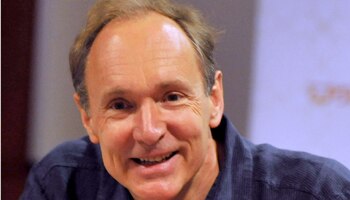
#TIM BERNERS LEE FACTS FULL#
The sources of Berners-Lee's concerns are three-fold: (i) state-sponsored hacking and attacks, criminal behaviour and online harassment (ii) systems where user-value is sacrificed (such as spammy websites full of advertisements and the viral spread of misinformation) and (iii) the polarised and outraged quality of much online content and debate. "The web has become a public square, a library, a doctor’s office, a shop, a school, a design studio, an office, a cinema, a bank, and so much more."īut it goes on to cast a more downbeat message and to ask governments and companies to sign up to the Web Foundation's Contract for the Web. In March 2019, Berners-Lee publicised the 30th anniversary of his original proposal for the world wide web by writing an open letter. Run through a for-profit company called Inrupt, it seeks to give people complete control over their digital data. Most recently, Berners-Lee has been working on a project at MIT called 'Solid'. He regularly speaks in support of the importance of uncensored access to the internet. Other projectsīerners-Lee continues to work with the development of the internet, including helping the British government establish its website, founding the Web Science Trust, and acting as a director of the World Wide Web Foundation. These days it has 476 member organisations and 62 full-time staff.
#TIM BERNERS LEE FACTS DOWNLOAD#
And I want the download to be fast and glitch-free." "I want this webpage to display in more or less the same way whenever it is loaded, regardless of what computer it is loaded on, what browser it is loaded with, and where in the world it is loaded. The initial home for W3C was the Laboratory of Computer Science at the Massachusetts Institute of Technology. In October 1994, Berners-Lee established the World Wide Web Consortium (W3C), whose mission is to develop protocols and standards to ensure the internet’s long-term growth. Amongst those aged 16-44, the UK Office for National Statistics reports that 99% have used the internet in the last three months. The UK, for example, has 90% usage rate for adults. In developed countries, the percentage of the population using the internet regularly exceeds 80%. Source: What percentage of adults use the internet? As of March 2019, there are an astonishing 1.67 billion websites. By 1998 Google had indexed 20 million webpages. The expansion of the web can be seen in other ways. The end of 2005 saw a billion worldwide users (about 15% of the people on the planet), the end of 2010 saw about 2 billion users (30%) and the current figure is 4.177 billion (or 60% of the people on the planet). Berners-Lee spent the next three years working on the design of the web and taking on board feedback from users.īy the millennium the number of web users had increased to 248 million (or 4.1% of the world’s population).

Everything there is online about W3 is linked directly or indirectly to this document, including an executive summary of the project, Mailing lists, Policy, November's W3 news, Frequently Asked Questions." What came next?īut the web was initially only one page wide. "The WorldWideWeb (W3) is a wide-area hypermedia information retrieval initiative aiming to give universal access to a large universe of documents.

The url is still live: why don't you check it out to see how far the internet has come? As you'll see, the first two lines were not particularly exciting! They stated: It had a somewhat clunky web address,, and explained what the world wide web was and how anyone could use a web browser and establish a web server. The first webpage was published on 6 August 1991. the first web server (the machine that provides this page to the computer that you are reading it on).the first web browser (the precursor of the application, such as Google Chrome, on which you are reading this page) and.So the challenge for Tim BL was to turn it into reality. "Vague, but exciting"īerners-Lee's friend and supervisor Mike Sendall (1939-1999) described his idea as “vague, but exciting”. "all of the documentation systems out there as being possibly part of a larger imaginary documentation system".
#TIM BERNERS LEE FACTS CODE#
Much of the technology was already there: hypertext language (the code that is read by web browsers) had been invented and companies used their own networks.īut Berners-Lee, who has described the situation in CERN as “desperate” (proving again that necessity is the mother of invention), married the technology together. In 1989, Berners-Lee returned to his vision for a world wide web.


 0 kommentar(er)
0 kommentar(er)
